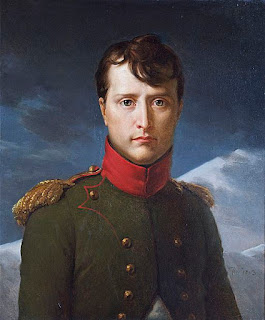On 5th October 1795 an ambitious young man named
Napoleon Bonaparte ordered a massacre that would start his rise to fame as one
of the dominant figures of European history.
Napoleon Bonaparte’s early service to France
Napoleon Bonaparte, who was born in 1769 on the French
island of Corsica, had distinguished himself from a young age as a military
commander by defending the French Revolutionary government against internal and
external threats. In particular, in 1793 Colonel Bonaparte successfully lifted
the siege of the port of Toulon by the British Navy. For this service he was
promoted to Brigadier General.
The National Convention
From 20th September 1792 the government of France
was in the hands of the National Convention, which was an assembly elected by
universal male suffrage. This body underwent a number of changes during its
three-year existence and a major change was proposed in 1795 that would create
a second chamber and a system of checks and balances.
A rule was proposed which meant that two-thirds of the
current deputies must be returned to the new assembly. This was presumably to
ensure a degree of continuity in that the new Convention would contain a good
number of experienced people who knew how to get things done. However, the move
did not prove popular in Paris, where an unlikely assemblage of hard-line
monarchists and equally hard-line left-wing revolutionaries formed a mob of
around 30,000 people who threatened to march on the Tuileries, the former royal
palace that was now the home of the Convention.
Bonaparte to the rescue
The commander of the Army of the Interior and the police was
Paul Barras, who was responsible for the security of the Convention. He called
upon Napoleon Bonaparte, who was otherwise unemployed, to organise a military
defence. Bonaparte’s strength was in artillery, so he ordered Major Joachim
Murat to gather 40 cannon and spread them around the outside of the building.
The rabble approached the Tuileries on the afternoon of 5th
October (or 13th Vendemaire, Year 4, according to the new Revolutionary
calendar). When the crowd was within close range Bonaparte announced “We’ll
give them a whiff of grapeshot” and ordered the cannons to fire. More than 200
protestors were killed and twice as many were injured.
The aftermath
There were no more such threats to the Convention, although
it did not last much longer. After a period known as the “Directory” during
which real power was held by five men, a coup d’etat in 1799 resulted in
ultimate power belonging to just one man, a certain Napoleon Bonaparte.
The whiff of grapeshot produced some other interesting
consequences. Paul Barras, who brought Bonaparte to the fore and invited him to
his home, had a mistress named Josephine de Beauharnais who was to become
Bonaparte’s wife within a year, and Barras, as the leading Director, would
eventually be sent into exile by Bonaparte.
However, better fortune befell Major Murat who would become
one of Bonaparte’s greatest generals and eventually acquire the title of King
of Naples.
© John Welford

Great article.
ReplyDelete